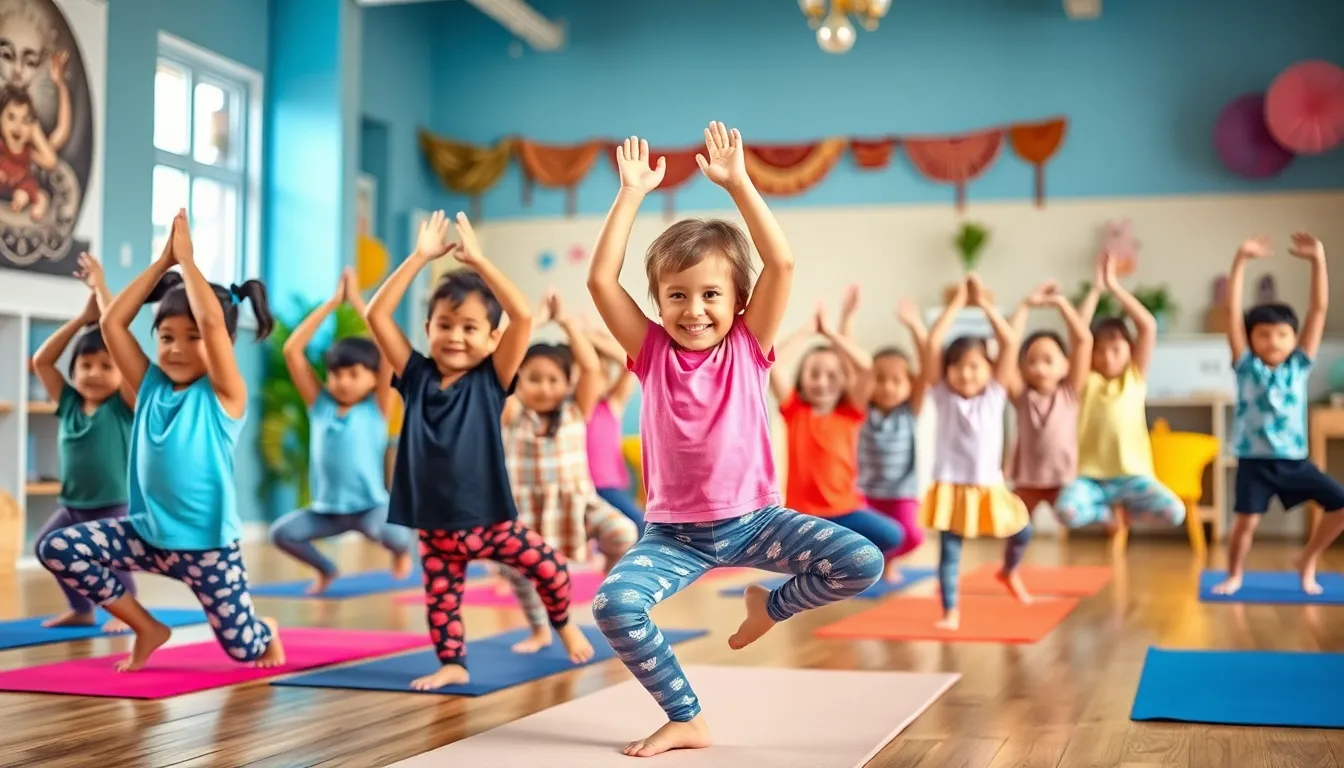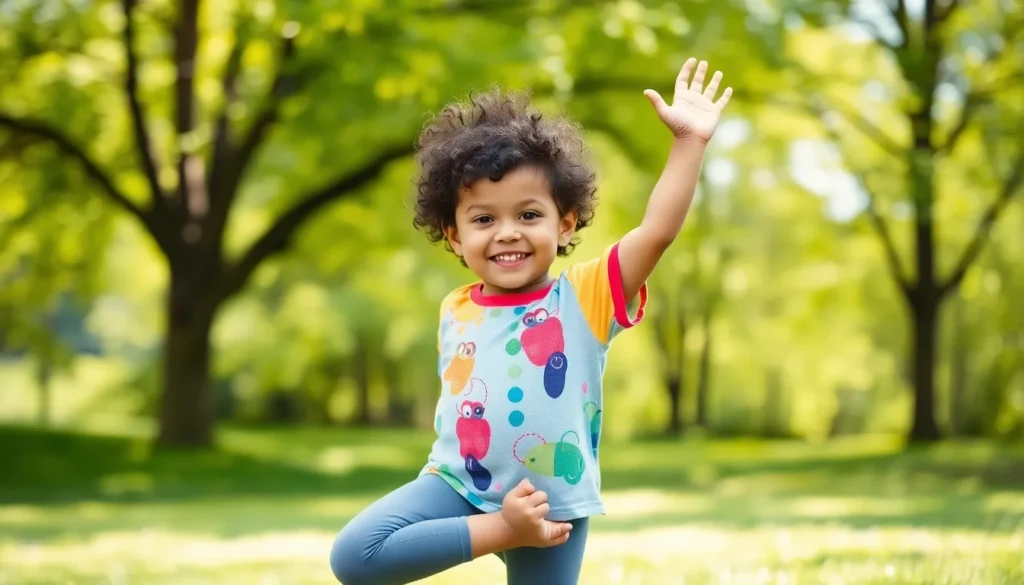Table of Contents
ToggleYoga isn’t just for adults; it can be a fun and beneficial activity for kids too. Introducing yoga to children as young as three can help them develop flexibility, balance, and focus while fostering a sense of calm. With simple poses designed for little ones, parents can create a playful environment that encourages movement and mindfulness.
Easy kid yoga poses not only promote physical health but also enhance emotional well-being. These poses can be adapted to fit any space, making them perfect for home or even a backyard. By incorporating engaging themes and stories, parents can make yoga a delightful experience that their kids will look forward to.
Benefits of Yoga for Kids
Yoga offers numerous benefits for kids, even as young as three. Engaging in yoga helps children develop essential physical, mental, and emotional skills.
Physical Benefits
- Flexibility: Simple poses promote flexibility in muscles and joints, enhancing overall movement.
- Balance: Practicing balance poses improves coordination and stability, supporting various physical activities.
- Strength: Yoga builds strength in core muscles, which contributes to better posture and injury prevention.
- Awareness: Children learn body awareness through different poses, fostering a connection between movement and breath.
Mental and Emotional Benefits
- Focus: Yoga enhances concentration by encouraging mindfulness, helping kids remain present in their activities.
- Stress Relief: Practicing yoga fosters relaxation, reducing anxiety and promoting a sense of calm.
- Self-Confidence: Mastering poses boosts self-esteem and encourages a positive self-image in children.
- Emotional Regulation: Yoga helps kids manage feelings by teaching techniques for self-soothing and emotional awareness.
Easy Kid Yoga Poses for 3

Easy kid yoga poses cater to the developmental needs of three-year-olds, promoting balance, flexibility, and relaxation. The following poses are designed to engage children and enhance their physical and emotional well-being.
Poses to Encourage Balance
- Tree Pose: Children stand on one leg, placing the other foot on the inner thigh or calf of the standing leg. Arms can reach upward or expand sideways like branches.
- Warrior III: Kids balance on one leg while leaning forward, extending the opposite leg straight back and arms forward. This pose helps improve body awareness.
- Flamingo Pose: While holding onto a wall for support, children lift one knee toward their chest and balance on the other leg. This pose enhances stability.
Poses to Promote Flexibility
- Butterfly Pose: Kids sit with the soles of their feet together, gently flapping their knees like butterfly wings. This pose opens the hips and encourages flexibility.
- Cat-Cow Stretch: In a tabletop position, children alternate between arching their back (cat) and dropping their belly (cow). This pose enhances spinal flexibility.
- Seated Forward Bend: Kids sit with legs extended and reach forward towards their toes. This pose stretches the back and hamstrings, enhancing leg flexibility.
Poses for Relaxation
- Child’s Pose: Kids kneel, sitting back on their heels, and lay their foreheads on the mat with arms extended or resting by their sides. This pose promotes calmness.
- Candle Pose: Children lie on their backs, lift their legs and arms while visualizing being a candle. This pose fosters relaxation and self-awareness.
- Savasana (Corpse Pose): Kids lie comfortably on their backs with arms at their sides. This pose encourages mindfulness and relaxation, perfect for winding down after practice.
Tips for Practicing Yoga with Kids
Creating a pleasant atmosphere encourages kids to enjoy yoga. Engaging their senses and imagination results in a positive experience.
Creating a Fun Environment
- Choose a colorful, comfortable space for practicing yoga.
- Use mats or blankets to define yoga areas.
- Incorporate calming music or nature sounds to set a soothing ambiance.
- Keep the practice light by allowing laughter and playfulness.
- Add props like stuffed animals or cushions to make poses exciting.
Ways to Engage Young Children
- Use stories or themes related to poses to spark interest.
- Incorporate playful elements, such as animal sounds, during practice.
- Allow kids to choose poses they want to do, fostering a sense of ownership.
- Integrate simple breathing exercises using counting or visual cues.
- Encourage participation through partner poses or group activities, making yoga a shared experience.
Safety Considerations
Safety remains a top priority when practicing yoga with three-year-olds. Awareness of the environment and adjustments to poses ensure children enjoy a safe and beneficial experience.
Supervision and Space
Supervision during yoga practice is essential. Adults should monitor kids to ensure they perform poses correctly and safely, preventing injuries. Choosing a clear, open space free of obstacles encourages freedom of movement. A non-slip surface, such as yoga mats, enhances stability. Ensure the area has adequate lighting for visibility, and remove any distractions to help maintain focus.
Modifications for Younger Children
Modifications make yoga accessible and safer for younger children. Adjust poses to match their developmental abilities, taking into account their flexibility and coordination. Use props like cushions or blocks to provide support in poses. Offer gentle variations of traditional poses, such as allowing kids to squat in place of more complex postures. Encourage them to listen to their bodies, promoting comfort and preventing strain. Engage them with playful language to motivate participation while ensuring practices align with their physical capabilities.
Introducing yoga to children as young as three can be a fun and rewarding experience. By incorporating easy poses and playful themes, parents and caregivers can create an enjoyable practice that promotes physical and emotional well-being.
The benefits of yoga extend beyond just movement; it fosters focus, balance, and relaxation in young minds. With thoughtful supervision and a safe environment, kids can explore their bodies while developing essential skills.
Encouraging a love for yoga early on sets the foundation for a lifelong appreciation of mindfulness and wellness. Embracing this practice can lead to happier and healthier children, ready to take on the world.




